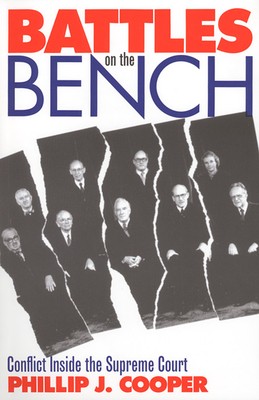
- We will send in 10–14 business days.
- Author: Phillip J Cooper
- Publisher: University Press Of Kansas
- ISBN-10: 0700609660
- ISBN-13: 9780700609666
- Format: 14.6 x 22.3 x 1.8 cm, softcover
- Language: English
- SAVE -10% with code: EXTRA
Reviews
Description
Felix Frankfurter's blustery depiction of debate within the Supreme Court suggests that combat sometimes supersedes collegiality in those hallowed halls. In fact, as Phillip Cooper shows, conflict is an inescapable fact of life in the Marble Temple.
Cooper peels back the calm, quiet public image of our judicial royalty to reveal their "family" feuds and squabbles. He shows that, whether motivated by deeply felt principle or by petty and vindictive impulses, these disputes dramatically shape the court's decision-making process, the justices' relations with one another, and the public's perception of the court. Filled with wonderful vignettes and telling anecdotes, Battles on the Bench illuminates the court's legendary and little-known clashes from John Marshall to Ruth Ginsberg and helps us understand why they fight, how they fight, and why their fights matter. In the process, it reveals a long tradition of strategic flattery, cajolery, name-calling, threats, subterfuge, and sermonizing-all in an effort to win over or run over fellow justices. Conflict in such high-stakes circumstances is hardly unexpected. But some of the court behavior is: Fred Vinson going after Frankfurter with a clenched fist and shouting that "no son of a bitch can ever say that to me!"; Frankfurter's dismissal of Justice Reed's intellect as "largely vegetable"; James McReynolds' undisguised anti-semitism toward Louis Brandeis; Antonin Scalia's harsh attacks on Sandra Day O'Connor; and William Rehnquist's sarcastic recital of a nursery rhyme and the "Star-Spangled Banner" before his startled brethren. Cooper, however, makes clear that to a surprising degree these justices do find ways to work together. As Earl Warren noted, life on the Court is like a marriage-one can't tolerate it if it's one battle after another. Appointed for life and completely independent, these "nine scorpions in a bottle" are nevertheless compelled to furl their stingers from time to time-for no justice can prevail without the support of at least four others. Indeed, one of the toughest questions Cooper tries to answer is why they don't fight more often. A rich treasure trove mined from the vast resources of judicial biography, Cooper's engaging study will be especially appealing to students and general readers with limited knowledge of the court's inner workings.EXTRA 10 % discount with code: EXTRA
The promotion ends in 20d.06:28:08
The discount code is valid when purchasing from 10 €. Discounts do not stack.
- Author: Phillip J Cooper
- Publisher: University Press Of Kansas
- ISBN-10: 0700609660
- ISBN-13: 9780700609666
- Format: 14.6 x 22.3 x 1.8 cm, softcover
- Language: English English
Felix Frankfurter's blustery depiction of debate within the Supreme Court suggests that combat sometimes supersedes collegiality in those hallowed halls. In fact, as Phillip Cooper shows, conflict is an inescapable fact of life in the Marble Temple.
Cooper peels back the calm, quiet public image of our judicial royalty to reveal their "family" feuds and squabbles. He shows that, whether motivated by deeply felt principle or by petty and vindictive impulses, these disputes dramatically shape the court's decision-making process, the justices' relations with one another, and the public's perception of the court. Filled with wonderful vignettes and telling anecdotes, Battles on the Bench illuminates the court's legendary and little-known clashes from John Marshall to Ruth Ginsberg and helps us understand why they fight, how they fight, and why their fights matter. In the process, it reveals a long tradition of strategic flattery, cajolery, name-calling, threats, subterfuge, and sermonizing-all in an effort to win over or run over fellow justices. Conflict in such high-stakes circumstances is hardly unexpected. But some of the court behavior is: Fred Vinson going after Frankfurter with a clenched fist and shouting that "no son of a bitch can ever say that to me!"; Frankfurter's dismissal of Justice Reed's intellect as "largely vegetable"; James McReynolds' undisguised anti-semitism toward Louis Brandeis; Antonin Scalia's harsh attacks on Sandra Day O'Connor; and William Rehnquist's sarcastic recital of a nursery rhyme and the "Star-Spangled Banner" before his startled brethren. Cooper, however, makes clear that to a surprising degree these justices do find ways to work together. As Earl Warren noted, life on the Court is like a marriage-one can't tolerate it if it's one battle after another. Appointed for life and completely independent, these "nine scorpions in a bottle" are nevertheless compelled to furl their stingers from time to time-for no justice can prevail without the support of at least four others. Indeed, one of the toughest questions Cooper tries to answer is why they don't fight more often. A rich treasure trove mined from the vast resources of judicial biography, Cooper's engaging study will be especially appealing to students and general readers with limited knowledge of the court's inner workings.

Reviews